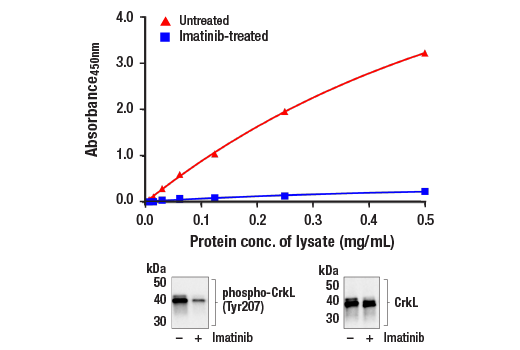| Product Includes | Product # | Quantity | Color | Storage Temp |
|---|---|---|---|---|
| Phospho-CrkL (Tyr207) Rabbit mAb Coated Microwells | 17435 | 96 tests |
|
+4C |
| CrkL Rabbit Detection mAb (Biotinylated) | 84578 | 1 ea |
|
+4C |
| HRP-Linked Streptavidin (ELISA Formulated) | 11805 | 1 ea |
|
+4C |
| Detection Antibody Diluent | 13339 | 11 ml |
|
+4C |
| HRP Diluent | 13515 | 11 ml |
|
+4C |
| TMB Substrate | 7004 | 11 ml |
|
+4C |
| STOP Solution | 7002 | 11 ml |
|
+4C |
| Sealing Tape | 54503 | 2 ea |
|
+4C |
| ELISA Wash Buffer (20X) | 9801 | 25 ml |
|
+4C |
| ELISA Sample Diluent | 11083 | 25 ml |
|
+4C |
| Cell Lysis Buffer (10X) | 9803 | 15 ml |
|
-20C |
*The microwell plate is supplied as 12 8-well modules - Each module is designed to break apart for 8 tests.
Description
The PathScan® Phospho-CrkL (Tyr207) Sandwich ELISA Kit is a solid phase sandwich enzyme-linked immunosorbent assay (ELISA) that detects endogenous levels of CrkL protein phosphorylated at Tyr207. A phospho-CrkL (Tyr207) rabbit antibody has been coated onto the microwells. After incubation with cell lysates, phospho-CrkL (Tyr207) protein is captured by the coated antibody. Following extensive washing, a biotinylated CrkL rabbit detection antibody is added to detect the captured phospho-CrkL (Tyr207) protein. HRP-linked streptavidin is then used to recognize the bound detection antibody. HRP substrate, TMB, is added to develop color. The magnitude of the absorbance for this developed color is proportional to the quantity of CrkL protein phosphorylated at Tyr207.
*Antibodies in this kit are custom formulations specific to kit.
Specificity/Sensitivity
Background
CrkL, a 39 kDa adaptor protein, has a key regulatory role in hematopoietic cells. CrkL has one SH2 and two SH3 domains, with 60% homology to CrkII (1). The amino-terminal SH3 domain of CrkL binds proteins, such as C3G, SOS, PI3K, c-Abl, and BCR/Abl. The SH2 domain of CrkL can bind to tyrosine-phosphorylated proteins, such as Cbl, HEF1, CAS, and paxillin (2,3). CrkL is involved in various signaling cascades initiated by different cytokines and growth factors. The biological outcomes of the Crk-activated signal transduction include the modulation of cell adhesion, cell migration, and immune cell responses (4). CrkL is a prominent substrate of the BCR/Abl oncoprotein in chronic myelogenous leukemia and binds to both BCR/Abl and c-Abl (5). CrkL is prominently and constitutively tyrosine phosphorylated in CML neutrophils and is not phosphorylated in normal neutrophils. Moreover, stimulation of normal neutrophils with cytokines and agonists does not induce tyrosine phosphorylation of this protein (6), indicating that it may be a useful target for therapeutic intervention or as a disease marker. Tyr207 in CrkL is the BCR/Abl phosphorylation site (7).
- Satter, M. and Salgia, R. (1998) Leukemia 12, 637-644.
- Feller, S. M. et al. (1998) J. Cell. Physiol. 177, 535-552.
- Kiyokawa, E. et al. (1997) Crit. Rev. Oncog. 8, 329-342.
- Feller, S. M. et al. (2001) Oncogene 20, 6348-6371.
- Grumbach, I. M. et al. (2001) Br. J. Haematol. 112, 327-336.
- Nicholas, G. L. et al. (1994) Blood 84, 2912-2918.
- de Jong, R. et al. (1997) Oncogene 14, 507-513.
Background References
Cross-Reactivity Key
H: human M: mouse R: rat Hm: hamster Mk: monkey Vir: virus Mi: mink C: chicken Dm: D. melanogaster X: Xenopus Z: zebrafish B: bovine Dg: dog Pg: pig Sc: S. cerevisiae Ce: C. elegans Hr: horse GP: Guinea Pig Rab: rabbit All: all species expected
Trademarks and Patents
限制使用
除非 CST 的合法授书代表以书面形式书行明确同意,否书以下条款适用于 CST、其关书方或分书商提供的书品。 任何书充本条款或与本条款不同的客书条款和条件,除非书 CST 的合法授书代表以书面形式书独接受, 否书均被拒书,并且无效。
专品专有“专供研究使用”的专专或专似的专专声明, 且未专得美国食品和专品管理局或其他外国或国内专管机专专专任何用途的批准、准专或专可。客专不得将任何专品用于任何专断或治专目的, 或以任何不符合专专声明的方式使用专品。CST 专售或专可的专品提供专作专最专用专的客专,且专用于研专用途。将专品用于专断、专防或治专目的, 或专专售(专独或作专专成)或其他商专目的而专专专品,均需要 CST 的专独专可。客专:(a) 不得专独或与其他材料专合向任何第三方出售、专可、 出借、捐专或以其他方式专专或提供任何专品,或使用专品制造任何商专专品,(b) 不得复制、修改、逆向工程、反专专、 反专专专品或以其他方式专专专专专品的基专专专或技专,或使用专品开专任何与 CST 的专品或服专专争的专品或服专, (c) 不得更改或专除专品上的任何商专、商品名称、徽专、专利或版专声明或专专,(d) 只能根据 CST 的专品专售条款和任何适用文档使用专品, (e) 专遵守客专与专品一起使用的任何第三方专品或服专的任何专可、服专条款或专似专专
